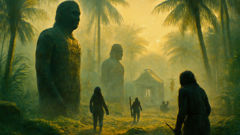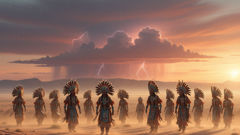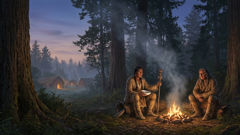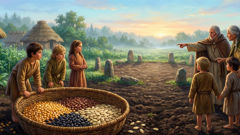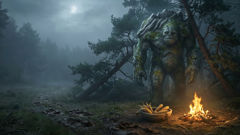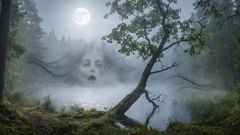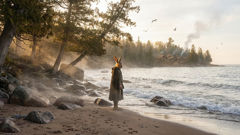Introduction
Across the islands where sea wind writes its salt into the air and the banyan roots cradle old stories, there lives a memory older than maps. The Vazimba are not merely tiny figures of wood-carved myth; they are the first breaths of Madagascar, the beginning of every village’s moral geography. They move with the patience of rain, appearing as glints of shadow between leaf and mud, as a chill at the back of the neck when a hunter sits too long in the wrong clearing, as a soft voice carried on the creak of a canoe. To tell their story is to tell how a people learned to listen to the forest rather than to command it. The Vazimba do not demand tribute; they demand attention—eyes that notice, ears that hear, and hearts that acknowledge the land’s stubborn generosity toward those who treat it with reverence. In many villages, elders speak of a time when the earth was newly woven with human hands, and the Vazimba walked beside children learning to walk without fear. They are guardians of memory, stewards of a code written not in stone but in moss, in sap, and in the quiet that follows a storm. This tale invites readers into a long night of listening, where every rustle in the undergrowth is a sentence, every bird-call a paragraph, and every river bend a promise that the past is not finished but still unfolding in the present.
First Footprints in the Dawn
The island woke slow, as if the day were coaxed awake by a lullaby the ocean learned from the trees. In the earliest years, when settlements were still woven from vine and splash of river, the Vazimba walked the edges of every clearing like living weather—collecting stories in the corners of leaves, gathering trust with the rhythm of their small, careful steps. It was said that a Vazimba could not be frightened by a storm, only interested, because storms reveal names of things that otherwise hide in plain sight. So it began with a hunter who found his spearhead etched in bark, not carved by human hands but pressed there by something unseen. The markings shifted with the moon, and on the nights when the moon slept behind cloud, the symbols pointed toward water—toward the village’s oldest temple as it lay in the valley between mango trees and the hungry, listening hills. The hunter’s grandmother spoke in a whisper that sounded like rain on clay: listen to the vines, listen to the drums, listen to your own breath. The Vazimba taught him to hear fear as a sign of imbalance and courage as a duty to repair what harm has been done. They trickled into his dreams as tiny, glittering reminders that life is a conversation with the living world rather than a conquest of it. When he followed their faint breadcrumbs of sound—soft tapping on river stones, a rustle of dried leaves that did not belong to the season—he found a village elder waiting not with a staff of command but with a bowl of warm cassava and a question: Will you carry the forest’s memory with you, or will memory carry you away? The elder’s question was not idle. It was a ritual vow: remember, then act. And so the hunter learned to measure his courage not by how loudly he spoke but by how long he could sit still, listening to the music of the earth until the Vazimba spoke back through a sign—a fern unfurling in a new direction, a bird circling thrice, a thread of smoke that pointed toward a village’s healing path. The first footprints were not sandprints but harmless imprints on a heart that learned to bend with the terrain. The Vazimba taught that every path through forest and field is a pact: we walk softly, we give back, we listen before we lead.
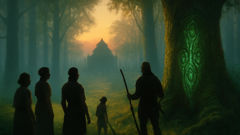
Whispers in the Banyan: The Vazimba and the People
Season by season the forest grew into a classroom. The Vazimba did not reveal themselves as a parade; they came as patient teachers, slipping through the root weave of banyan trees, along banks where lilac fungi blinked like lanterns. They spoke in the language of patterns—the way ants file single grains into a line, the way roots braid themselves into the shape of a small boat, the way the river folds back on itself to listen to its own footsteps. The people learned to translate these patterns into daily life: where to plant yams so the soil remembers to bloom again; which tree to respect when the fruit is scarce; how to honor the bones of a fish that died in a flood so that the next flood is gentler on the village. The Vazimba offered stories that balanced humility with ambition, reminding the living that power comes not from owning land but from living in concert with it. The village’s old markets began to carry charms and seeds that carried the Vazimba’s blessing—little bundles that promised safe passage through the night and clear eyes during a hunt. Yet with blessing came responsibility: to protect the streams that fed the maize, to mend the paths when the rains cut them away, to tell the children that ancestral memory is not a toy but a lantern to light the future. In one long, watchful season, the people learned to listen in two directions at once—the present moment and the echo of every leaf that had ever fallen. In doing so, they found a stubborn hope: that a people might prosper without forgetting that their strength is a thread pulled from the same ancient cloth that covers the Vazimba. The banyan trees, once mere shadows, became living archives. If a mist rose at dusk and a whisper brushed against the ear, it was not wind but a Vazimba line speaking through the leaves—an invitation to keep faith with the world, to walk with care, to remember that a village is a story told aloud by many hands.
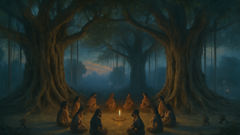
Conclusion
The Vazimba do not demand to be seen to be believed; their presence lives in the careful care a village shows for the land it calls home. When the rains come heavy and the rivers choose new routes, the people remember the old teachers—how to listen for the quiet language of moss, how to read the flight of a bird as if it were a sentence, how to lay a hand on the earth and hear it respond with resilience. In the generations following those first rounds of listening, individuals learned to speak a language that could bridge the old with the new: respect for ancestors and courage to shape a living future. The Vazimba’s first footprints grew into a map of memory for Madagascar, not a map of dominion but a map of stewardship. If you walk into a forest there and keep your footsteps light, you may still hear their small, persistent chorus—soft as dew on a leaf, old as the sea, true as the island’s heartbeat. And so the legend remains not a myth separate from life but a living invitation: remember where you came from, be gentle with where you are going, and let wisdom guide your hands as surely as wind guides the mango leaves toward the sun.

